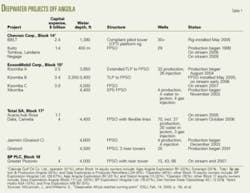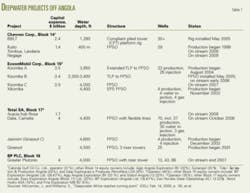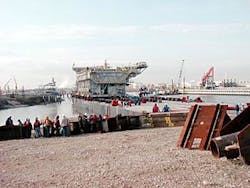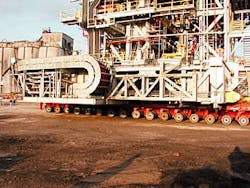New rig installed in deep water off Angola
Chevron Corp. has installed a new 4,600 hp platform rig on the compliant piled tower in the Benguela Belize fields off Angola and will begin production later this summer from wells predrilled in 2004. Other operators are moving forward with a variety of deepwater development projects in Angola (Table 1).
According to Wood MacKenzie, Angola dominates deepwater production in West Africa, already producing about 600,000 bo/d in 2005, about 80% of West Africa’s deepwater production, followed by Nigeria (OGJ, Feb. 14, 2005, p. 18).
Angola’s national oil company Soc. Nacional de Combustiveis de Angola (Sonangol EP) administers offshore leases. In a 1997 joint venture, Sonangol and Pride Petroleum Services Inc. began construction of the deepwater drillship Pride Africa for work off Angola. In November 1999, the newly constructed Pride Africa began operations off Angola.
Elf Exploration Angola drilled off Angola 1996-99 with the deepwater semisubmersible Jim Cunningham under a 36-month, $117 million contract with Reading and Bates Corp.
In 1998, Elf entered a 5-year contract for the Pride Angola deepwater drillship. In fourth-quarter 2003, Pride entered into contract extensions for the Pride Africa and Pride Angola drillships through 2010.
In 2001, Pride received a contract to construct, commission, and operate a deepwater platform drilling rig for Esso Exploration Angola’s Kizomba A tension leg platform in Block 15 (Table 1). The rig was delivered and installed on the TLP in 2003 and began operating in November. Pride’s management contract expires in December 2008.
Houston-based Quest Offshore Resources Inc.’s 2004 statistical review showed that West Africa orders accounted for 32% of the global subsea production market (362 subsea trees, predominantly from FMC Kongsberg Subsea AS and Vetco Gray Inc.), followed by the North Sea with 28%.1
Quest estimates that West Africa will account for 34% of all subsea tree orders in 2005, followed by the North Sea with 21%. In 2006, Quest foresees West Africa and the Mediterranean leading subsea tree orders worldwide. Quest estimates that operators will spend $4.5 billion on subsea hardware for West Africa and the Mediterranean in 2005-10.
Block 14 history
ChevronTexaco became operator of Block 14 in 1995 and began drilling in 1996, making the first discovery at Kuito in 1997. Production from Kuito began in December 1999; the field was producing more than 70,000 bo/d by late 2001.
The next discovery wells drilled were Landana (1998), Benguela (June 1998), Belize (October 1998), Tomboco (2000), Lobito (August 2001), Tombua (2001), Gabela (early 2002), and Negage (late 2002).
According to Chevron’s Douglas Goff, more than 1 billion bbl of recoverable oil have been discovered in 15 reservoirs under the Block 14 exploration permit.2
The Benguela and Belize fields are about 4 km south of the Kuito field. The Benguela 2A and Belize 2A appraisal wells were completed in January 2000 and December 1999, respectively. ChevronTexaco announced in February 2000 that the Beguela 2A well tested 8,400 bo/d of 24° and 34º API (American Petroleum Institute) gravity crude. The Belize 2A well flowed 11,000 bo/d of 36º crude.
The Tomboco discovery well was drilled in early 2001 and tested more than 17,000 bo/d from two separate zones, according to ChevronTexaco in October 2001.
The Lobito-1X discovery well was drilled in August 2001 in 1,340-ft water. In September, it tested 10,200 bo/d of 35° API gravity crude. At that time, CABGOC planned to invest $6 billion in Angola over the following 5 years.
The Negage discovery well was drilled in 4,738-ft water. It was ChevronTexaco’s ninth discovery on Block 14.
Chevron’s wholly owned subsidiary Cabinda Gulf Oil Co. Ltd. (CABGOC) operates the Block 14 Contractor Group, which includes Cabinda Gulf Oil Co. Ltd. (31%), Agip Angola Exploration BV (20%), Sonangol Pesquisa & Producao SARL (20%), Total Exploration & Production Angola (20%), and Portugal’s Petrogal Exploration (Galp-Exploracao e Producao Petrolifera LDA; 9%).
BBLT
Chevron’s Benguela Belize-Lobito Tomboco development in Angola is one of the company’s top five projects worldwide. Located in the Lower Congo basin off Angola in 1,280-ft water, 1,560-sq-mile Block 14 is the deepwater extension of the Chevron-operated Cabinda concession, which contains seven commercial discoveries. The first of these to be developed on the block was Kuito field (Table 1).
Chevron drilled nine development wells in the BBLT predrill program in 2004 to “narrow the uncertainty” by testing each reservoir interval and provide seismic calibration points. The results were presented by John Moore, Chevron’s BBLT asset team, at the AAPG International Conference in Cancún, October 2004,3 and by Bill G. Higgs, BBLT team lead, at the NAPE/AAPG First West Africa Deepwater Regional Conference, in Abuja, Nigeria, November 2004.4
Infrastructure
Chevron is now finishing installation of the first compliant piled tower (CPT) outside of the Gulf of Mexico. The 1,290-ft CPT is designed to be an integrated drilling and production platform hub, with a single platform rig.
In February 2003, CABGOC awarded a $120 million contract to Abbot Group subsidiary KCA Deutag Drilling Inc. for design, engineering, procurement, construction, and operation of the new platform rig for the Benguela Belize field development. The project was managed from KCA Deutag’s Houston office. National Oilwell was responsible for the drilling equipment and commissioning the rig (EPC), using its facilities in Stavanger, Edmonton, and Houston.
First steel was cut in September 2003 and the primary steel fabrication was completed by Omega Natchiq, based in New Iberia, La. In May 2004, the structures were brought to National Oilwell’s Galena Park facility on the Houston ship channel and the drilling package was installed.
The new rig can drill to 30,000 ft and employs variable frequency AC drives. The derrick is equipped with 4,600-hp drawworks, a top drive with 60,000 ft-lb torque, and it can support a 1.3-million-lb hook load. It has three 2,200-hp mud pumps rated to 7,500 psi capable of handling 4,625-bbl total mud volume.
The 4,600-hp rig was launched on Jan. 14, 2005, and John Nicholl’s, KCA Deutag vice-president, noted that the rig was completed with more than 750,000 accumulated hr, injury free.
The topsides contractor, Daewoo Shipbuilding and Marine Engineering Co. Ltd., subcontracted Heerema Marine Contractors for transporting the rig to Angola and installing it on the CPT. In February 2005, the three rig modules and the accommodation quarters left Houston on two Crowley barges. They arrived in Angola in May and KCA Deutag was responsible for the hookup and commissioning of the drilling package.
The 5-year drilling program will begin later this summer. According to Houston-based Quest Offshore Resources Inc., Chevron will drill 10 wells in 2006 and 11 wells in 2007 at BBLT.5 Production is scheduled to begin late this year from Benguela and Belize fields.
Lobito, Tomboco
By early 2007, subsea wells in the Lobito and Tomboco fields will also be tied back to the Benguela Belize CPT, 3-5 miles away. Three drill centers are in water 1,300-1,800 ft deep, about 50 miles offshore. Production is expected to reach 200,000 bo/d by 2009.
In July 2004, CABGOC awarded a 3-year, $125 million “life-of-field” contract to Vetco Gray for the engineering, manufacture, and installation of subsea equipment at the Lobito Tomboco development. It includes 22 subsea horizontal trees, 6 manifolds, integrated subsea and surface control systems, spares, and options for additional trees and manifolds, according to a Vetco Gray press release. The company’s facilities in Scotland, England, Norway, and Angola are contributing to the project.
Vetco Gray has been involved in Block 14 operations in Angola since Chevron’s 1997 discovery of the Kuito field.
Total
Total SA operates the Dalia field, a development worth about $3.4 billion. The subsea system includes 67 wells, possibly increasing to 71 wells. The Dalia field is in 4-5,000 ft water, about 84 miles off Angola, near Girassol in Block 17 (Table 1). Dalia’s oil is about 21° API gravity, while Girassol’s is 32° API gravity. Total’s partners are ExxonMobil, BP, Statoil, and Norsk Hydro.
In late 2002, Total and Sonangol awarded the pre-engineering contract for Dalia and later the EPC contract for the subsea production system to Aker Kvaerner. It includes 67 christmas trees and wellhead systems for 34 production wells, 30 water injection, and 3 gas injection wells.
According to a June 24, 2005, press release, Total has exercised an option for the use of Ocean Rig ASA’s Leiv Eiriksson semisubmersible drilling rig in Angola for a 1-year term. This extension will follow the current six-well contract.
BP
BP Angola and Shell Exploration & Production Angola BV hold the Block 18 exploration permit. In 1999, they drilled the Platina and Plutonio wells, and in 2000 they drilled four more wells: Galio, Paladio, Cromio (October), and Cobalto (December) using the deepwater drillship Pride Angola. All within 20 km, these form the Greater Plutonio development. BP plans an FPSO with a riser tower, with first oil projected for 2007.
Angola training
KCA Deutag began pre-training Angola personnel in 2004, a year before operations would commence.Esso Angola trains personnel in Nova Scotia at Cape Breton University(CBU) and the Nova Scotia Community College (NSCC) Marconi campus in Sydney. The school partnership designed a custom program for Exxon-Mobil projects in Angola. The 12-month program trained 13 people in 2002 and 20 in 2003-04. On July 8, 2005, eight Angolan and Russian students graduated from the CBU petroleum program.6 The schools offer a state-of-the-art operations lab developed with industry partners. ✦
References
1. Press release, Quest Offshore Resources Inc., Feb. 24, 2005.
2. Goff, D., Pacavira, N., et al., “Exploration in Block 14, Offshore Angola: Geologic Insights from a Decade of Experience,” 2005 AAPG International Conference, Paris, Sept. 11-14, 2005.
3. Moore, J.G., Chicato, P.V., et al., “Narrowing Uncertainty by Pre-Drilling Development Wells: Benguela, Belize, Lobito & Tomboco Fields, Block 14, Angola,” 2004 AAPG International Conference, Cancun, Oct. 24-27, 2004.
4. Higgs, W.G., Moore, J.G., et al., “Narrowing Uncertainty by Pre-Drilling Development Wells: Benguela, Belize, Lobito and Tomboco Fields, Block 14, Angola,” NAPE/AAPG First West Africa Deepwater Regional Conference, Abuja, Nigeria, Nov. 14-18, 2004.
5. Quest Offshore Resources Inc. (www.questoffshore.com).
6. www.ocean-resources.com



